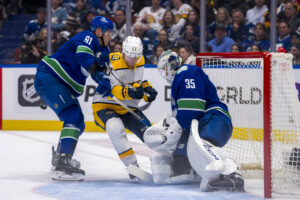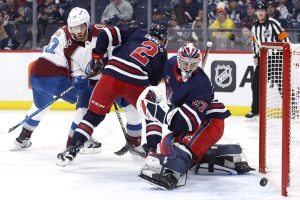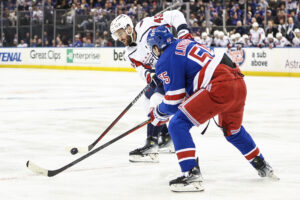Anton Lundell should be a top-10 consensus pick. That’s it. That’s the article. It boggles my mind how Lundell could possibly slide out of the top-10 regardless of how strong the draft is. He’s one of the most well-rounded prospects in the draft, already plays against men, and, being one of the oldest prospects, he’s one of the most mature as well.
Anton Lundell Should be a Top-10 Pick
First off, let’s get this out of the way; yes, Lundell is one of the older first-year eligible players in this draft. That said, his maturity is a little further ahead, giving him a slight advantage above other prospects. The reason I bring it up is because Twitter folk think it’s a big enough reason to bump him down, simply because he’s a few months older.
His slight age advantage gave his Liiga team, HIFK, and it’s coaching staff some trust, allowing him to have a bigger role than most kids his age. That’s a fair enough reason to believe his lack of production is slightly concerning. I mean, he was deployed a fair amount and was given a larger role, so why did he only post 10 goals and 28 points in 44 games?
Anton Lundell’s Defensive Deployment
You’d imagine Lundell, a guy praised for his defensive capabilities, would be thrown to the wolves and put in a mainly defensively-focused role. But again, the trust his coaching staff exhibited due to being a little bit older, proved otherwise. Over a span of four Liiga games, Lundell started eight of his shifts in the defensive zone, which is just a 9.4 percent start rate. Consider the fact that 50.6 percent of his shifts started on-the-fly, and you understand why it is such a small margin. But even with on-the-fly shifts removed from the equation, he still only started 19% of those shifts in the defensive half of the ice.
If percentages don’t really sell you on just how lopsided the numbers are, Lundell started seven shifts in the defensive zone and one on the defensive side of the neutral zone. Meanwhile, he also started 26 of his shifts in the offensive zone and two on the offensive side of the neutral zone. These numbers truly show just how lopsided his deployment was, so again, his somewhat lackluster results are concerning.
However…
Yes, his production was small, to a degree. Yes, his deployment was certainly offensively-driven, and it was a slight misconception to believe otherwise. But, there’s more than meets the eye. Let’s take a look at some familiar Finnish players who once played in Liiga: Aleksander Barkov and Patrik Laine. Barkov finished his Liiga “career” with 85 games played, scoring 28 goals and 36 assists for 64 points, which is a 0.75 point per game pace. Not bad for a 17-turned-18-year-old at the time. As for Laine, he played far less games with just 52 in total, recording 17 goals and 17 assists for 34 points, which is a 0.65 point per game pace.
Lundell was not far behind them. He played 82 games in Liiga, to this point, which is just behind Barkov. Again, him being on the older side allowed him to earn a sooner call-up than most, but it is still incredibly impressive that a 17-year-old played against men for this long. Not to mention, Liiga isn’t exactly a cake-walk either. But in that 82-game span, Lundell had 19 goals and 28 assists for 47 points, which is a 0.57 point per game pace. Now, that isn’t bad for a teenager in a men’s league, but it is slightly below that of Laine’s and far below Barkov.
Deeper Dive?
It’ll take a deeper dive than that. How about something called involvement percentage (INV%)? That’s the percentage of the total team goals in which said player was involved, whether they scored or assisted on a goal. In their Liiga careers, Barkov and Laine finished with a 21.19 INV% and a 10.56 INV%, respectively. For Lundell, he finished with a 13.35 INV%.
His possession stats are also absurd, and will surely translate into more offensive results as he continues to grow. He was the best player on his team in Corsi-for percentage, which was a 61.9 percent score in his draft year. Laine, in his draft year, was down at 53.3 percent. And if you want to be the one to claim Lundell’s age and prior experience gave him an advantage over Laine in his draft year, then here’s Lundell’s DY-1 Corsi: 54.9 percent. Still better than Laine’s by a considerable value. Quite simply, Lundell was considerably better than Laine, even arguably in his DY-1 season, and Laine wound up a 2nd overall pick. Albeit, Laine was in a far weaker class, at least based on prior expectations.
Anton Lundell Film Review
Skating
Lundell’s stats clearly back up the big picture here. He stands up with previously drafted high-end draft picks. But there’s a lot more to look at than stats. There has to be a balance. For old school fans and fans who don’t fully believe in more advanced analytics, this one’s for you! The good ol’ eye test. First up, let’s look at Lundell’s skating ability.
Lundell (#15 in white) begins with the puck along the boards. He takes it behind his own net. Noticing the pressure, he plays the puck to a teammate along the boards and chases the chipped puck. He isn’t a speedy skater, but he uses his awareness and good speed to get by pic.twitter.com/s1kULvzSmq
— kyle pereira (@pereira_report) September 19, 2020
There are a few things to unpack here. First, his overall speed. He isn’t slow by any means. He gets up ice and chases after the puck he sent, and he only lost the race because the opponent was in the area that the puck was sent to. But it’s also clear he isn’t a burner either. His strides are short, and that takes away from any potential power in a full extension.
He also leans forward a bit much rather than keeping his back straight and his chest up. Add that to the fact that he doesn’t have the best knee bend either, he should bend his knees lower for more power, and you have a fairly poor skating technique. However, it doesn’t limit him by any means, and it also shows that if he were to work out those small kinks, he could be a near-elite skater. There’s potential there.
Anton Lundell’s Defensive Zone Play
This right here is the kicker. Lundell offers a ridiculous amount of value in the defensive zone already at a young age. First of all, his body and stick positioning is wonderful, and it compares favorably to some of the best two-way forwards in the game today. Think Patrice Bergeron and his anticipation paired with that positioning. It’s like painting on a beautiful canvas, and Lundell is a masterful artist.
First, we have this clip below. Lundell is alone in the slot, with an opposing forward in front with him. The two HIFK defenders chased the puck around behind the net and into the corner, and Lundell knew he needed to keep tight to his man. He positioned himself perfectly between the puck and the opposing forward, using both his body and an active stick. He clogged the passing lane effectively when the opposing puck carrier came out from the battle and back behind the net, and he wasn’t fooled when the puck carrier threw a behind-the-back pass out front to the man he was covering, breaking up the play.
Lundell? Prides himself on getting to the dirty areas and having strong stick positioning. The first example is him (15 in red) as the lone defender in the slot. He watched the play behind the net while keeping an eye on the open man. Clogs a potential passing lane brilliantly pic.twitter.com/ZXT2XYCH6d
— kyle pereira (@pereira_report) May 29, 2020
On top of all that, he does this kind of thing consistently. His anticipation, ability to keep track of bodies around him, his stick and body positioning, and his active stick make him a strong and reliable option, consistently.
Physicality in the D-zone
Lundell isn’t exactly the biggest, not to mention he’s one of the younger players in a men’s league, so it’s no surprise he relies more heavily on his positioning and IQ in the defensive zone. However, he still gets to the dirty areas and battles along the boards. He certainly doesn’t shy away, and he isn’t the easiest to hold off either. In the clip below, we see Lundell aggressively engage along the boards. Using his stick checking in tight, he’s able to initially push the puck up along the boards. It gets sent back down to the opposing player he challenged almost right away, but using his short-area quickness and strong edgework, he sticks right with his man, up until he makes a drop pass along the boards.
Getting to the dirty areas? How about grinding it out along the boards in the toughest league in Finland? Against men? Because Lundell does that here pic.twitter.com/iCmERTiAfH
— kyle pereira (@pereira_report) May 29, 2020
In another instance, yet again Lundell initiates the battle. He expertly pins the opposition along the boards with his knee between the puck carriers legs and his arms on either side of his body to effectively trap that player. Using his skates, along with the help of teammates, he works the puck free. After a few seconds, HIFK gets possession, and Lundell races up ice for a potential breakaway. Unfortunately, the pass was off the mark.
Lundell (15 in white) expertly pins his opponent along the boards. Knee between the legs, hip on hip, arms on either side and leaning in. Puck worked out, he chases and deflects the pass to cause a turnover. Awareness shown to get on his horse and up ice. Pass is off a bit though pic.twitter.com/qRlW52LT2F
— kyle pereira (@pereira_report) September 19, 2020
Anton Lundell’s Forechecking Makes a Difference
Part of the defensive game is forechecking. The opposing team has the puck. The player is trying to force a turnover or take the puck away himself in some way. That’s, in a vacuum, defending. Lundell is good at it. It also helps establish offensive zone time, which adds to his overall game. In the clip below, Lundell charges in with a full head of steam and knifes the puck away and spins past his opponent. He then collects the loose puck, darts towards the net, and fires a quick wrist shot past the blocker for the goal.
Last bit of film on Lundell, my favorite clip @SammyT_51 @Vezinalevskiy pic.twitter.com/XrI089ARLU
— kyle pereira (@pereira_report) June 2, 2020
In another clip below, Lundell isn’t forechecking, but he is facing the rush. He backs up to the defensive blueline, stick out in front of him, anticipating. As soon as the opposing puck carrier looks to move the puck to a teammate along the boards for a zone entry, Lundell jumps up and robs the puck from them. He then quickly gets up ice and fires a quick shot on net. He actually looks across at a teammate the whole time, and shoots without looking at the goalie. However, the goalie was ready and swallowed up the shot.
More Lundell love. Patience from 15 in red, steps up with a takeaway. Two on one, he looks pass the whole way then wrists one on net. Goalie was ready pic.twitter.com/XJNIWMXyK5
— kyle pereira (@pereira_report) September 27, 2020
Anton Lundell Has No Offensive Potential?
In the wise words of our own Ben Kerr on Lundell’s offense: “He is a smart player who always seems to be in the right spot… Lundell is also effective in front of the net, where he can get rebounds and deflections. He is able to extend plays by controlling the puck down low and working in the cycle game.” Truer words have never been spoken. Lundell is commonly found getting to the net-front. He also has one heck of a shot, but doesn’t use it enough. In the clip below, Lundell rips a shot from the high slot, going bar-down.
Pretty damn good for a guy with not much offensive upside… pic.twitter.com/5rOohBkV0o
— kyle pereira (@pereira_report) June 1, 2020
And getting to the net-front? Consistency there. Lundell makes a home there at times, especially right at the sides of the net, by the posts. His vision and hockey IQ allow him to sneak pucks in front when he gathers in passes or fire shots in at the short side. He’s also very good at coming off the post to set up for one-timers in soft spots, depending on the situation. But here’s a compilation of Lundell making plays in tight.
Compilation of Anton Lundell driving the front of the net in some way because he has offensive potential. None of these are goals, but the intent is there #2020NHLDraft @SammyT_51 pic.twitter.com/0SXqULx3nX
— kyle pereira (@pereira_report) September 26, 2020
Lundell’s hockey IQ
His vision is excellent. His anticipation is top-notch. That vision comes in all different ways, from finding and sticking with his man in the defensive zone, exploiting defensive zone coverages with his positioning, and with how he moves the puck. When he combines that with his anticipation, it can result in plays like the one below, where he anticipates his teammate getting in behind the opposing defensemen and puts it in a spot where his teammate can simply skate right into it. Brilliant.
Lundell (#15 in red) with a brilliant and quick read and pass to a teammate for a quick re-entry into the offensive zone pic.twitter.com/SwV1eAsYk3
— kyle pereira (@pereira_report) September 26, 2020
The next clip is another show of Lundell’s IQ and vision. In overtime, Lundell receives a pass along the boards from a teammate who was pressured. His clean pick up of the puck along the boards allowed him to keep his feet moving. That’s anticipation – knowing his teammate would be able to play the puck up the boards for him – to grab the puck smoothly. He realizes he has a two-on-one opportunity and moves the puck across to a teammate before entering the zone. Lundell receives a pass back soon after entering the offensive zone and, without even looking across at his teammate, slides it right back through traffic. He hits his teammate tape-to-tape and in stride for his teammate to bury the OT winner.
Lundells give and go for the OT winner over KalPa. Excellent read, pass through traffic and a good finish pic.twitter.com/kI9UwaSDdU
— kyle pereira (@pereira_report) September 26, 2020
Puck Movement
Lundell is very good at moving the puck in the offensive zone as well. On the powerplay, especially, he stands out with his quick, smart passes. He acts as a facilitator, and can slow the game down or speed it up as he so chooses. On this powerplay, for example, he works near-side along the half-wall. He moves the puck back and forth between his teammate below the goalline and his teammate at the point. He let’s off a one-timer and makes a cross-ice pass in that same sequence. They don’t score here, but he moves the puck fluidly and with a purpose. He can be dangerous.
Lundell (15 in white) shows excellent positional awareness on the PP. he gets into an open area, displays smart passing and strong vision. He also calls for a pass as he skates towards the net and gets a good look in tight. He then quickly sets up for a one timer shortly after pic.twitter.com/zB6wTAQQGz
— kyle pereira (@pereira_report) September 19, 2020
Transitional Game
Lundell’s transitional game is also solid. When it comes to breaking out of the defensive zone, in the four games I’ve tracked, Lundell broke out with control on 65.22% of his attempts. Compare that to a guy like Alexis Lafreniere, who I’ve also tracked for four games, and he has a 67.86% clip. Lundell also dumps or clears the puck out of the defensive zone on 17.39% of his attempts, while Lafreniere sits at 21.43%. Finally, Lundell failed to clear the defensive zone 17.39% of the time, same as when he cleared. Meanwhile, a guy like Lucas Raymond, who also plays in Europe, fails at a 33.33% clip, a massive difference from where Lundell sits, in the same spam of four games.
When it comes to breaking into the offensive zone, Lundell sits a good distance back from guys like Lafreniere and Quinton Byfield, in terms of total attempts entering the offensive zone. However, that’s not a knock on him – he plays in a mens league while Lafreniere and Byfield are superstars in a Junior league. So, for comparison’s sake, let’s stick to comparing him to Raymond. Lundell enters the offensive zone with control on 46.88% of his attempts, while Raymond sits at 53.57%. Lundell dumps the puck in at a 34.38% clip, and Raymond does so at a 35.71% clip. The most glaring number is how often Lundell fails to gain entry, as he sits at 18.75% compared to Raymond’s 10.71%.
Overall
Lundell is an excellent defensive forward, but everyone already knew that. His defensive game is a combination of awareness, stick checking, willingness to get physical, anticipation, and short-area quickness. His defensive game can translate quite well to the NHL, especially considering the ice surface will get smaller, meaning less room to cover defensively. Lundell’s skating is above-average, but it has the qualities to become elite with the right skating coach. His transitional game is among the top in this draft, though he could become better with his zone entries. Finally, his offensive game is strong, with untapped potential.
His style of play in the offensive zone – play the perimeter and, when the time is right, attack the net with speed – can and will have success. His shot is powerful and accurate, though still a bit inconsistent. But he can fool goalies with subtle decisions, like no-look shots and no-look passes, as seen in the clips above. His sneaky good passing ability and overall feel for the game will continue to grow, and as he adds more muscle and works on his accuracy, his shot will become lethal. It’s not a matter of “if” someone will unlock that potential. It’s a matter of “when.” If Lundell falls past 10th overall, there are going to be at least 5 general managers who will be kicking themselves a few years down the road.
Main Photo:
Embed from Getty Imageswindow.gie=window.gie||function(c){(gie.q=gie.q||[]).push(c)};gie(function(){gie.widgets.load({id:’oKE5GkxoQgJ9S23iUoKB_w’,sig:’SZKO27Bi51qwjFDicYOV5ZFexUKo4DUscTI0pIdx7Jw=’,w:’594px’,h:’400px’,items:’1090697262′,caption: true ,tld:’com’,is360: false })});






